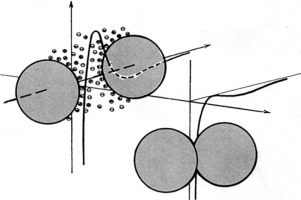Advances in Colloid and Interface Science ( IF 15.9 ) Pub Date : 2018-06-19 , DOI: 10.1016/j.cis.2018.06.004 Jarl B. Rosenholm

|
Factors influencing the sign and size of effective surface (zeta) potential in suspensions of very low dielectric constants are evaluated. For non-aqueous suspensions it was found that Gutmann's donor number (DN = negative Lewis type molar acid-base adduct formation enthalpy) was successfully related to zeta potential changes, similarily as pH is optimal for aqueous suspensions. Negative molar proton dissociation enthalpy (Brϕnsted type HD number), negative hydrogen bond enthalpy (HB number), logarithmic hydrogen bond equilibrium constant (molar Gibbs free energy), standard reduction potential of solvated protons (Eo(HL+/H2)), electrolytic dissociation potential of water (Eo(H2O/H2, O2)) and electron exchange Fermi potentials could equally well be related to zeta potential changes. All these properties were linearly dependent on each other. Correlations to products of Gutmann's DN and AN numbers and other relevant properties such as polar, hydrogen bond and acid-base contributions to solubility parameters and surface tensions were found to be less successful particularly when very polar liquids were encountered. Commonly used DLVO models for repulsive interaction energy between particles in aqueous electrolyte suspensions have been simplified when dealing with low-polar, non-polar and apolar suspensions. When evaluating factors contributing to attractive and repulsive interaction energies, it is found that in order for the models to be relevant the extension of diffuse charging has to be much larger than the distance to repulsive barrier ensuring suspension stability. At this limit and at high surface potentials, the repulsive energy grows exceptionally large being in the range of lattice energy of each solid. The models fail when surface potential is low and the extension of diffuse charging is much smaller than the distance to repulsive barrier. Then interaction energies are reasonable. The investigated Au, SiO2, Glass, TiO2, Al2O3, CaCO3, MgO suspensions fall between these limits. The attractive energy is small but significant as compared to repulsive energy. All energies were larger than the estimated lower limit for stable suspensions.
中文翻译:

非水悬浮液中颗粒带电的评估
评估影响介电常数非常低的悬浮液中有效表面(ζ)电位的符号和大小的因素。对于非水悬浮液,发现Gutmann的供体数(DN =负路易斯型摩尔酸-酸基加合物形成焓)与ζ电位变化成功相关,类似地,pH值对于水悬浮液也是最佳的。负摩尔质子离解焓(Brϕnsted型HD数),负氢键焓(HB数),对数氢键平衡常数(摩尔吉布斯自由能),溶剂化质子的标准还原电势(E o(H L + / H2)),水的电解解离电势(E o(H 2 O / H 2,O 2))和电子交换费米电势都可能与zeta电势变化相关。所有这些特性彼此线性相关。与Gutmann的DN和AN产品的相关性 发现数量和其他相关性质,例如极性,氢键和酸碱对溶解度参数和表面张力的贡献不太成功,特别是在遇到极性很大的液体时。在处理低极性,非极性和非极性悬浮液时,简化了用于水性电解质悬浮液中颗粒间排斥相互作用能的常用DLVO模型。当评估有助于吸引和排斥相互作用能的因素时,发现为了使模型相关,扩散电荷的扩展必须比到确保悬浮稳定性的排斥屏障的距离大得多。在此极限和高表面电势下,排斥能在每个固体的晶格能范围内异常增大。当表面电势低且扩散电荷的扩展范围远小于到排斥势垒的距离时,模型将失败。那么相互作用能是合理的。研究的金,二氧化硅如图2所示,玻璃,TiO 2,Al 2 O 3,CaCO 3,MgO悬浮液在这些极限之间。与排斥能相比,吸引力很小,但意义重大。所有能量均大于稳定悬架的估计下限。











































 京公网安备 11010802027423号
京公网安备 11010802027423号